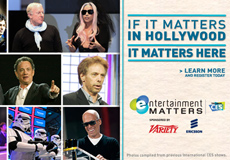 Entertainment Matters at CES
Entertainment Matters at CES (EM), currently in its second year, is an International CES program created specifically for the Hollywood and entertainment community. EM includes
On the Floor, which targets relevant exhibits for content and entertainment professionals;
Keynotes and Panels that address key trends, technologies, media and branding; the
Red Carpet Program, an exclusive, invitation-only VIP program to CES;
and
Next Generation, a custom experience for tomorrow’s entertainment media leaders. Sponsored by
Variety and Ericsson, EM is a tailored connection to partnerships and innovations at the world’s largest consumer electronics tradeshow, the
2012 International CES® (January 10-13 in Las Vegas).
DTS, Technicolor, LG, Sony and ESPN 3D are just a few of the more than 2,700 leading tech companies exhibiting at CES
On the Floor – from global giants to emerging startups – unveiling innovative new products and services and showcasing the collaboration between content creators and CE manufacturers.
The
Red Carpet Program is an insider’s view of global technology and content, and access to potential business opportunities. It is an invitation-only VIP program open to select executives, directors, producers and talent (contact:
RedCarpet@CE.org). Red Carpet benefits include:
- Free access to the CES show floor
- Access to private Red Carpet Lounge on the show floor (LVCC, North Hall)
- Preshow and on-site service, including a dedicated hotline
- Priority VIP passes to Keynote Addresses*
- 20% discount on Entertainment Matters Conference Pass
- Customized guided tours of show floor*
- Access to exclusive VIP parties and special events*
*Space is limited.
For Hollywood’s
Next Generation leaders
, EM provides a custom experience designed to introduce this highly networked and influential community to the CES experience. The program targets tomorrow’s studio chiefs, content producers, leading actors, agents and attorneys (contact: Hollywood@CE.org). Next Generation benefits include:
- Free access to the CES show floor
- Curated/guided tour of the show floor*
- Free access to select Entertainment Matters Conference Sessions
- 20% discount on full Entertainment Matters Conference Pass
- Access to invite-only Thursday evening event
* Space is limited.
Additionally, CES provides relevant news updates twice a week with the Entertainment Matters Digital Content SmartBrief (
EM SmartBrief), covering news essential to the digital entertainment industry (to subscribe:
www.smartbrief.com/ceadigital).
Click
here to register for Entertainment Matters. Use priority code
EM13 and receive free registration and a 20% discount on the Entertainment Matters Conference Pass. (You must be a working professional in the content and entertainment industry.)



